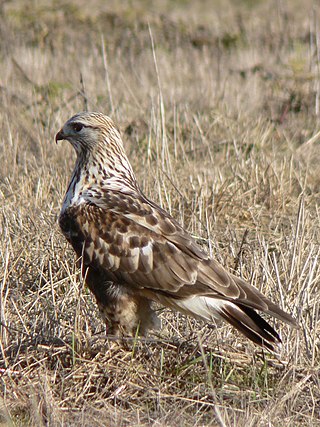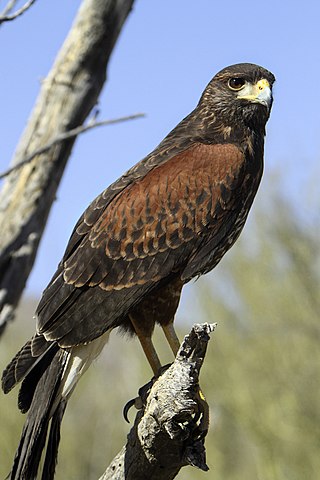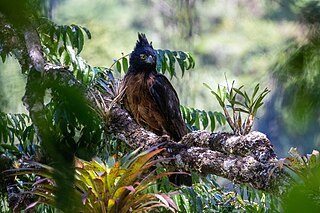
The common buzzard is a medium-to-large bird of prey which has a large range. It is a member of the genus Buteo in the family Accipitridae. The species lives in most of Europe and extends its breeding range across much of the Palearctic as far as northwestern China, far western Siberia and northwestern Mongolia. Over much of its range, it is a year-round resident. However, buzzards from the colder parts of the Northern Hemisphere as well as those that breed in the eastern part of their range typically migrate south for the northern winter, many journeying as far as South Africa.

Eagle is the common name for the golden eagle, bald eagle, and other birds of prey in the family Accipitridae. Eagles belong to several groups of genera, some of which are closely related. True eagles comprise the genus Aquila. Most of the 68 species of eagles are from Eurasia and Africa. Outside this area, just 14 species can be found—two in North America, nine in Central and South America, and three in Australia.

Hawks are birds of prey of the family Accipitridae. They are very widely distributed and are found on all continents except Antarctica.

The Accipitridae is one of the three families within the order Accipitriformes, and is a family of small to large birds of prey with strongly hooked bills and variable morphology based on diet. They feed on a range of prey items from insects to medium-sized mammals, with a number feeding on carrion and a few feeding on fruit. The Accipitridae have a cosmopolitan distribution, being found on all the world's continents and a number of oceanic island groups. Some species are migratory. The family contains 255 species which are divided into 70 genera.

Buteo is a genus of medium to fairly large, wide-ranging raptors with a robust body and broad wings. In the Old World, members of this genus are called "buzzards", but "hawk" is used in the New World. As both terms are ambiguous, buteo is sometimes used instead, for example, by the Peregrine Fund.
Buzzard is the common name of several species of birds of prey.

The rough-legged buzzard (Europe) or rough-legged hawk is a medium-large bird of prey. It is found in Arctic and Subarctic regions of North America, Europe, and Russia during the breeding season and migrates south for the winter. It was traditionally also known as the rough-legged falcon in such works as John James Audubon's The Birds of America.

The ferruginous hawk is a large bird of prey and belongs to the broad-winged buteo hawks. An old colloquial name is ferrugineous rough-leg, due to its similarity to the closely related rough-legged hawk.

The changeable hawk-eagle(Nisaetus cirrhatus) or crested hawk-eagle is a large bird of prey species of the family Accipitridae. More informal or antiquated English common names include the marsh hawk-eagle or Indian crested hawk-eagle. It is a member of the subfamily Aquilinae, with signature feathers, absent in tropical raptors from outside this subfamily, covering the tarsus. It was formerly placed in the genus Spizaetus, but studies pointed to the group being paraphyletic resulting in the Old World members being placed in Nisaetus and separated from the New World species. It is a typical “hawk-eagle” in that it is an agile forest-dwelling predator and like many such eagles readily varies its prey selection between birds, mammals or reptiles as well as other vertebrates. Among the members of its genus, the changeable hawk-eagle stands out as the most widely distributed, adaptable and abundant species. Individuals show a wide range of variation in plumage from pale to dark, varying with moult and age giving rise to the name "changeable".

Harris's hawk, formerly known as the bay-winged hawk, dusky hawk, and sometimes a wolf hawk, and known in Latin America as peuco, is a medium-large bird of prey that breeds from the southwestern United States south to Chile, central Argentina, and Brazil. This bird is sometimes reported to be at large in Western Europe, especially Britain, but it is a popular species in falconry and these records almost invariably all refer to escapes from captivity.

The ornate hawk-eagle is a fairly large bird of prey from the tropical Americas. Formerly, some authorities referred to this species as the crested hawk-eagle, a name that may cause some confusion as it is more commonly used for an Asian eagle species. Like all eagles, it is in the family Accipitridae. This species has a feathered tarsus that marks it as a member of the Aquilinae or booted eagle subfamily. This species is notable for the vivid colors and bold markings of adults, which differ considerably from the far more whitish plumage of the juvenile bird. The ornate hawk-eagle ranges from central Mexico south through much of Central America and in a somewhat spotty but broad overall range into South America, including in the west apart from the Andes and broadly on the Atlantic side especially Brazil down to as far as Southeast Brazil and northern Argentina. This species is found largely in primary forests with tall trees, although can be found in many forest types.

The gray-headed kite is a raptor found in open woodland and swamp forests. It shares the genus Leptodon with the extremely rare white-collared kite. It breeds from eastern Mexico and Trinidad south to Peru, Bolivia, Brazil and northern Argentina.

The white-eyed buzzard is a medium-sized hawk, distinct from the true buzzards in the genus Buteo, found in South Asia. Adults have a rufous tail, a distinctive white iris, and a white throat bearing a dark mesial stripe bordered. The head is brown and the median coverts of the upper wing are pale. They lack the typical carpal patches on the underside of the wings seen in true buzzards, but the entire wing lining appears dark in contrast to the flight feathers. They sit upright on perches for prolonged periods and soar on thermals in search of insect and small vertebrate prey. They are vociferous in the breeding season, and several birds may be heard calling as they soar together.

The solitary eagle or montane solitary eagle is a large Neotropical eagle. It is also known as the black solitary eagle.

Buteogallus is a genus of birds of prey in the family Accipitridae. All members of this genus are essentially neotropical, but the distribution of a single species extends slightly into the extreme southwestern United States. Many of the species are fond of large crustaceans and even patrol long stretches of shore or riverbank on foot where such prey abounds, but some have a rather different lifestyle. Unlike many other genera of raptor, some members are referred to as "hawks", and others as "eagles".

The black-faced hawk is a species of bird of prey in the family Accipitridae. This low-density species has traditionally been believed to be restricted to Amazon Basin north of the Amazon River, but there are several records south of this river, in, for example, the Brazilian states of Pará and Acre, and southeastern Peru. It is closely related to the white-browed hawk and individuals showing a level of intermediacy between the two species are known, suggesting that they rarely hybridize

The barred hawk is a species of bird of prey in the family Accipitridae. It has also been known as the black-chested hawk.

The black-and-chestnut eagle is a large South American species of bird of prey in the family Accipitridae. It is sometimes called Isidor's eagle. It is often placed in the monotypic genus Oroaetus. However, recent genetic testing indicates that this species is fairly closely related to Spizaetus species and thus the species should be included in that genus. The black-and-chestnut eagle is a typical forest raptor, hunting primarily small to medium-sized mammals and birds and constructing a large nest in a tall tree. Unfortunately, the twin causes of habitat destruction and persecution, justified or not as an occasional poultry killer, have caused strong population declines and the black-and-chestnut eagle is considered to be an Endangered species by the IUCN.

The black-and-white hawk-eagle is a bird of prey species in the eagle and hawk family (Accipitridae). It is found throughout a large part of tropical America, from southern Mexico to northern Argentina.

The variable hawk is a polymorphic species of bird of prey in the family Accipitridae.


























